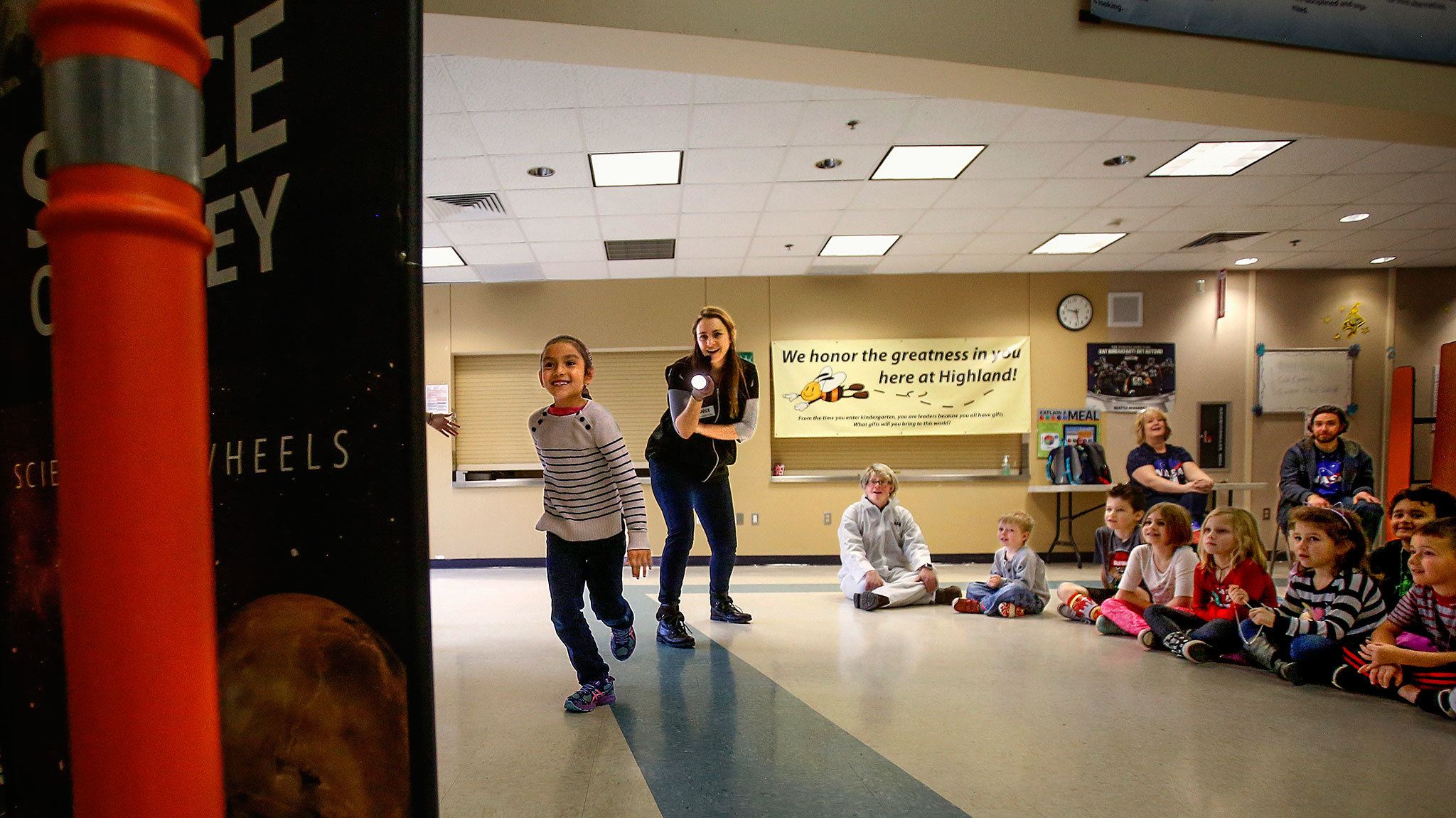LAKE STEVENS — Visitors from the Pacific Science Center surprised students at Highland Elementary School with a trip to space Thursday.
The center’s Science on Wheels program brings high-energy activities to schools. Thursday’s event at Highland included an assembly, in-class lessons and interactive exhibits set up all over the campus.
For kindergarten through second grade, the morning kicked off with an assembly. A couple hundred students sat on the floor for an introduction to astronomy. They struggled to keep quiet as Janice Crew, Kate Wellens and Mike Sweeney from the Pacific Science Center launched into their “Space Odyssey.”
Crew told the kids she wants to go to space and thought she was all prepared, with a green backpack of supplies and an orange bicycle helmet. That made Liliahna Hall-Rogers, 7, laugh because she already knew a bicycle helmet wouldn’t be much help in space.
Wellens explained the vacuum of space and demonstrated by putting a pink balloon with a smiley face — representative of Crew’s head if she didn’t wear a proper space suit — in a clear container and using a machine to suck out the air. The balloon swelled, then popped. In the audience, kids’ eyes went wide and some jaws dropped, though Liliahna had suspected it would end badly for the pink balloon.
The Pacific Science Center team also talked about the distance from Earth to the moon, and the sun and the next nearest star. They explained how far a light year is and how fast light moves by asking first-grade student Ava Aguero to run as fast as she could in one second. They found that one “Ava second” measures about 10 feet. At that speed, Ava could circle the Earth twice in one year. In comparison, the speed of light is fast enough to circle the Earth more than seven times in one second.
After the assembly, students headed to classrooms, the gym and the library. In the gym, activities included connecting star maps into constellations, piecing together a puzzle of the galaxy and standing on scales that told them how much they would weigh on different planets due to the varying gravity.
Ayden Guarino-Rice, in fourth grade, liked the scales. He found out he would weigh 155 pounds on Jupiter, he said. That’s “a lot more” than the 10-year-old weighs on Earth.
Fourth-grade teacher Lela Hoover wanted students to understand how important science is, and that their teachers care about them and want them to have fun while they learn.
“I hope they feel empowered to research on their own if they’re interested,” she said.
The science day was planned by teachers, who work in teams on projects for the school. Bailey Abdo, a second-grade teacher, helped coordinate. After students left school Wednesday, staff set up areas for exhibits and decorated for the surprise space lessons. Teachers and other employees wore costumes Thursday, with Principal Ryan Henderson wearing a white space suit and helmet and folks in the front office answering the telephones as “mission control.”
“I hope that the students are inspired to learn more about science and space,” Abdo said. “I hope that they’re engaged in all their learning today because some of it is very high rigor for their grade level. And I just hope they really enjoy school today.”
Justice Michaud, 7, is in Abdo’s class with Liliahna. Their class made space helmets out of paper bags.
Justice thinks it would be fun to go to space. He’d like to find aliens.
Liliahna isn’t interested in leaving Earth.
“There’s dangerous things there,” she said. “I’m staying at home.”
The Science on Wheels team is set to visit Jackson, Forest View and Hawthorne elementaries in Everett next week, according to the science center. Topics vary. At Jackson and Hawthorne, they plan to talk about engineering.
The Science on Wheels program started during the energy crisis in the 1970s, when schools and families couldn’t afford to transport kids to the science center in Seattle. Staff from the center started loading exhibits and lesson supplies into station wagons so they could bring science to kids. Over the past 10 years, the science center estimates the program has reached more than 1.5 million children and adults.
Kari Bray: 425-339-3439; kbray@heraldnet.com.
Talk to us
> Give us your news tips.
> Send us a letter to the editor.
> More Herald contact information.






























